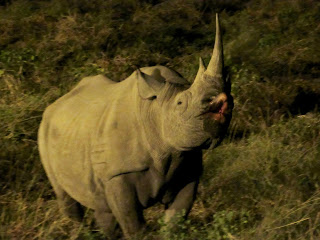This morning is our last full day of six days in Etosha
National Park, Namibia. We are at the Dolomite Rest Camp in the western end of
the park. Tomorrow we start the second week of our Namibia segment by
journeying south to the giant dunes and desert land. Day #28 of our 66-day trip
around the world and it seems like we've been gone for a long time AND are a
long way from home.
Life in the park essentially consists of driving around from
waterhole to waterhole to view the incredible assortment of animals. All the
roads are dirt\gravel. The quality ranges from compacted excellent to
corrugated teeth-jarring poor. Since we are now in the dry season the roads
generate a lot of dust that invariably makes it way into the car and our lungs.
The roads are well marked and the water holes are generally within a few
kilometers from the main road. All of the water holes are manmade and wells
that are powered by either windmills or solar panel are used to pump the water
up and out into the reservoirs. All the animals know where the water is...they
are either there, walking to it or walking away from it. The eastern part is flat;
the western part is more mountainous. If you took the State of Alabama and
turned in sideways, that would be about the size of the park. This is a true
fact: Since we arrived in Namibia a week ago, we have not seen ONE cloud. Not
one. The sky is brilliant sapphire blue, slight breeze, low eighties during the
day but high forties at night. Zero humidity.
We stayed in four different rest camps. Our last
one...Dolomite Rest camp is the newest camp in the park (2011) and is perched
high up on a mountain with just twenty villas facing towards the sunset. The
view is just amazing as the pictures here will attest. We previously posted
about our first camp, Ontoshi Rest Camp. The other two where we stayed one night
each reminded us more of the Kruger National Park camps in that they were rock roundels,
large camps, lots of campers, RV's, etc. All camps are fenced and gates closed
at night to keep out the dangerous animals that roam the park freely. The two
middle camps had bush braai facilities (BBQ pits to us Americans) that we used
both nights for our dinner. The bush braai is the classic Namibian thing to do
so we jumped right in with pork chops, tatters and corn the first night and
game rump (don't ask), taters and corn the second night.
As a general observation, the facilities are a bit run down.
Maintenance seems to be a low priority and while the places were clean and hygienic,
they all could use a major spring- cleaning. We just kept reminding ourselves
that we ARE in the bush...far from civilization and the beauty, the scenery
more than made up for the shortfall in quality standards. Local Namibians staff
all the facilities. They are courteous but they move mighty slowly...unless
there's money involved which then improves things greatly. We have tried to be
extra generous and frequent with the tips...a $10 Namibian note is equal to
about $.70 U.S. but it always brings a huge smile and we suspect it greatly
supplements their wages and their quality of life
So, that's an overview of Etosha. It's hard to comprehend
that vast places like this really exist on the planet...isolated parts of the
park that have never been touched by human footprints. But, we are ready to
move on. The following pictures are just a few of the hundreds and hundreds
we've taken.
 |
| Our too small car |

Our Little hut
The Rhinos: The first series of shots were at nighttime in Okaukuejo Camp
On our route the next morning..
The flamingos
The elephants: We watched this guy come out of the bush to the water hole. It was fascinating!
The family of elephants was viewed from our hut at Dolomite, walking across the plains and then we went to the waterhole for closeup pictures.
 |
| Zebra photo bomb! |
 |
| Political stand-off.... |
Pool reflections.






























































